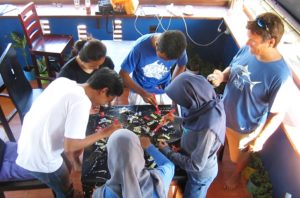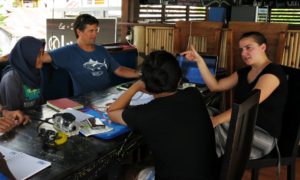During our internship we have learned a lot about fisheries, marine sustainability, and the role of governance and policy. Today, the mentors prepared a fun way to help us better understand these concepts. We began the day by playing a game called “What’s the Catch?”.
Andy played the role of the fishery manager, while the rest of us were fishermen. Andy spread four different types of candy on a table top, and told us that they each represent different types of marine life: target species, juvenile target species, endangered marine wildlife, and coral reefs.
Each of us fishermen had $10, and we have to spend it wisely to by fishing gears and fishing quotas, otherwise we might go bankrupt and be unable to fish. We can sell our catch and earn $1 for each target fish caught.

Fishing with chopsticks and spoons to catch our target species
Andy told us when the fishing season started and stopped, and each season he introduced different rules. We had a time limit, or a catch quote, or fishing licences. The winner is the fisherman who makes the most money, and the losers are the ones who go bankrupt. We could choose whether to buy selective fishing gears or destructive fishing gears. Just like a real fishery, right?
The game made us think about how different regulations and management plans incentivise different behaviours. We saw that a timed fishing season encourages fishermen to adopt destructive gears the harvest quickly, whereas tradable quotas can help fishermen to earn money optimally while also protecting the environment.
After the game, we watched a video about fisheries economics and policy effectiveness, and learned about individual and transferable quotas. It was interesting to see how fishermen can choose to either harvest a portion of the total allowable catch, or sell their quotas to other fishermen.
After lunch, we had a special guest from NatureBank, a Canadian carbon trading and environmental investment company. Cornelia Rindt talked about he carbon market and interdicted us to the Great Bear Forest Carbon Project. Carbon trading is a way for a company to limit or offset it’s carbon dioxide emissions. It was interesting to learn how the concepts we had learned about during the morning’s fishing game can be applied to other issues to incentives and create behaviour change. We all found it complicated but very interesting. We can’t even see carbon dioxide, and yet we can trade it to help protect the world from greenhouse gases.

Learning about carbon markets and the Great Bear Rainforest Project with Cornelia Rindt from NatureBank
Today’s discussions made me understand that people are actually aware when they impact nature, and can use regulations and markets (or punishments and incentives) to limit destructive behaviour and encourage sustainable activities. I think we all agree that by protecting nature, we are actually protecting ourselves, and this is a very valuable and important need.


